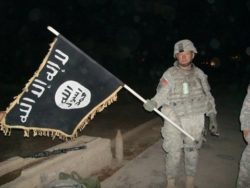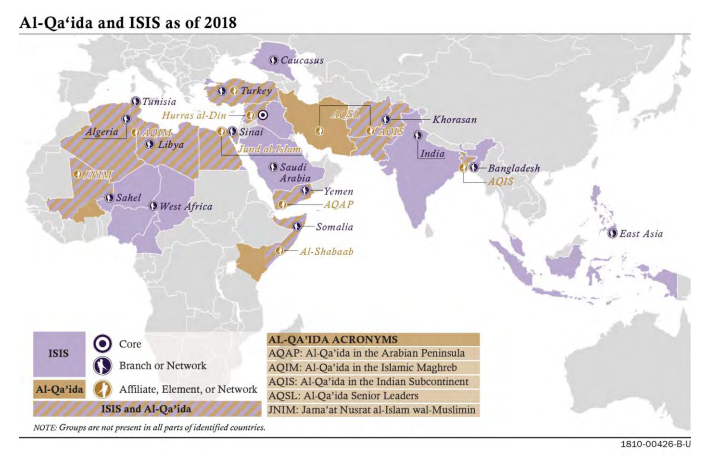 Photo Credit: US Army
Photo Credit: US Army
When Terrorist Organizations Refuse to Die: A Prediction for ISIS through the Examination of IMU
On December 19th, President Trump tweeted that “we [the United States] have defeated ISIS in Syria.” Since then, Trump has claimed on 15 additional occasions that “ISIS had been defeated or would be eliminated within hours or days.” Trump’s statements do not encompass the complexity of the situation.
History has shown that as long as a group retains even a few passionate members, a strong ideology, and the ability to adapt, it is possible to rebuild from next to nothing. Weak organizations no longer seen as a threat will often join with other terrorist groups to impose damage on civilians. Today’s situation with ISIS will likely follow the same path as the Islamic Movement of Uzbekistan (IMU).
The Islamic Movement of Uzbekistan
IMU is the longest lasting Central Asian militant group in modern history. Similar to ISIS, IMU seeks to establish Islamic rule throughout the countries in which it operates. Historically, the group has been active in Afghanistan, Tajikistan, Kyrgyzstan, Iran, Pakistan, and Uzbekistan. IMU wages war against anyone who is seen to be an enemy of its Islamic mission. This goal involves expelling Western interests from Central Asia, principally through violent attacks. IMU activities include the 2000 kidnapping of four American mountain climbers, the 2012 attack and freeing of approximately 400 prisoners from the Bannu Prison in Pakistan, and the 2014 attack on Pakistan’s Jinnah International Airport that resulted in 39 deaths.
Some consider the group to have become virtually extinct since 2015 after the Taliban’s retaliation of IMU’s betrayal and new allegiance to ISIS. However, IMU remains a threat due to its loyal followers, involvement with a variety of terrorist activities, and strong regional allies. The few remaining IMU members continue to show their resilience through their loyalty to the organization and its mission.
IMU has been able to adapt by changing its alliances to other major terrorist organizations. Between 1998-2002, IMU tied itself to al-Qaeda, which supported the Uzbek-based group logistically and financially. Al-Qaeda also trained IMU’s initial militant members in Afghanistan. Another major ally was the Taliban. Until 2015, the Taliban financed and supported many of IMU’s operations. Today, IMU is allied with ISIS. ISIS funds IMU and helps raise the group’s profile. In return, IMU provides linkages across Central Asian countries. In recent years, ISIS has capitalized upon IMU’s network to expand its activities into Afghanistan.
The Islamic Movement of Uzbekistan is an example of an organization that should not exist or continue to be a threat. Despite its diminished size, the group has continued to persist, making the news as recently as May 5th as it continues to recruit fighters in Afghanistan. By attaching itself to larger organizations, including the Taliban and Al-Qaeda, this passionate and resilient group has remained active with only a few remaining members.
Where Does ISIS Fit In?
Like IMU, ISIS has demonstrated its ability to adapt. ISIS is clearly capable of evolving, as the group emerged from al-Qaeda in Iraq after the U.S. led a strategy to defeat the group by 2006/2007. Even as the organization diminishes in size and territorial possessions, a core group of passionate members will strive to recreate the power the organization once possessed, perhaps under a different name. As evidenced with IMU, a terrorist organization does not need to hold onto land to continue to remain a threat. ISIS can use its persuasive ideology to continue to inspire people worldwide.
Furthermore, ISIS has an incredible network of allies. As Director of National Intelligence Daniel Coats pointed out, “ISIS still commands thousands of fighters in Iraq and Syria, and it maintains eight branches, more than a dozen networks, and thousands of dispersed supporters around the world, despite significant leadership and territorial losses.” This can be seen below in the map of al-Qaeda and ISIS networks as of late 2018, provided by the DNI’s 2019 Worldwide Threat Assessment Report.

As such, ISIS will continue to pose a serious global threat. As ISIS loses strength and prestige, it will inevitably increase its brutal and unpredictable guerrilla warfare tactics. The United States must be prepared for continued violence and should remain active in disrupting ISIS’ networks, money flows, and messaging capabilities. History has demonstrated that this organization is far from being truly defeated.





